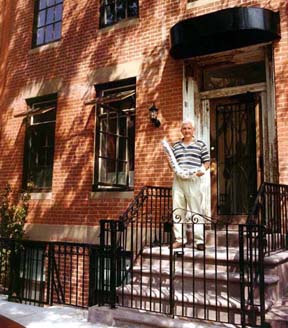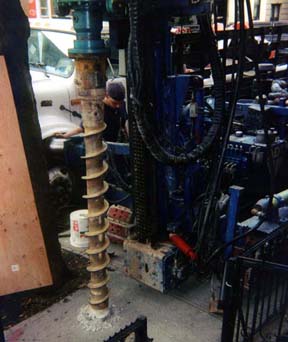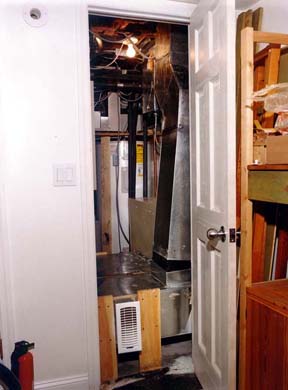
Sumple is president of CHW, LLC, in New Milford, Conn. When the new owner of a four-story townhouse located on the lower west side in the Chelsea section of Manhattan purchased the 2,400-square-foot building, he decided to completely gut and renovate his new home. He began researching heating and cooling systems on the Internet, and being both environmentally conscious and wanting an efficient system, he decided on a direct-access ground-source heat pump from ECR Technologies, Inc., Lakeland, Fla. The ECR Web site referred him to Sumple as the local area dealer.
According to Sumple, a direct-access heat pump had never before been installed in Manhattan. Since this was the first project of its type, it was a more difficult and time-consuming process to get the necessary permits. “There were additional questions that had to be answered to satisfy the building officials,” he said. After about a month, the permits were in hand.

Drilling In The Sidewalk
The project required drilling three vertical bores, 100 feet deep, for the ground loops for the geothermal heat pump. Drilling was difficult as well because it had to be accomplished in a tight 5-foot by 20-foot section of sidewalk between the townhouse and the street. And a tree in front of the building could not be damaged or it would result in a $15,000 city fine.“The drilling rig had to be small because we could not block the street and we also had to keep a walkway around the site for pedestrians,” said Sumple. The tree was protected with plastic sheathing and plywood. A special drill head was also used.
“Since we drilled into gravel in the first 40 feet under the sidewalk before we hit bedrock, we had to install casing in that 40-foot section to keep the hole from caving in,” he continued. An Odex head was used to drill and install the casing and then remove the casing when drilling was completed.
After the three holes were bored, a trench was dug into the basement. Three copper loops were installed in the holes, connected to manifolds (vapor and liquid). A lineset was run from the manifolds to the heat pump.

Direct Geothermal
ECR’s EarthLinked™ direct-access ground-source heat pump uses copper loops containing refrigerant, instead of the usual water loop of a standard geothermal system, for direct heating and cooling of the refrigerant by the earth. In the winter, the copper loops and heat pump transfer heat from the warmer ground into the house. During the summer, the process is reversed; heat is removed from the home and transferred into the ground, which is cooler than the outside ambient air temperature.The direct-access system’s copper refrigerant loop, Sumple noted, only required a 4-inch bore hole in this application compared to the 8-inch hole that would have been needed with a water-loop geothermal system. He said the copper loop only requires 100 feet per ton of capacity compared to 150 feet per ton with a water loop. The smaller holes and reduced hole depth provided a 50 percent savings on drilling vs. what a water-loop system would have cost, he pointed out.
Plus, the very tight quarters in this case would have prohibited a water-loop system. “The drilling rig would have been too large,” said Sumple.
Another advantage, he said, is that “Any HVAC technician can service the direct-access geothermal unit because it’s just like an air conditioning system.”

High-Velocity Air
The 3-ton EarthLinked heat pump in this installation is used along with a Model ESP-V high-velocity air-handling system, from SpacePak, a Mestek company, Westfield, Mass. The air handler is also installed in the basement.The small-diameter flexible ducts and small air outlets used with this unit ease installation and create a less obtrusive system, commented Sumple. Air is moved at 2,000 fpm compared to the 500 fpm of a conventional system.
The high-velocity air distribution system uses the principle of aspiration, mixing the air and providing more thorough air circulation. This helps prevent stratification, minimizing floor-to-ceiling temperature difference and supplying a more even temperature in the room.
A total of 20 discharge outlets were installed in the townhouse. On the upper level, two of the outlets had to be modified to blow down 15 degrees from horizontal to get proper airflow due to the architecture of the master bedroom. One return grille was installed per floor.
The townhouse also includes ECR’s DHW heat exchanger and a hot water tank, which are used with the heat pump to provide hot water year round. Hot water has priority over heating and cooling with this system. “A three-way valve is used to satisfy hot water needs first, then go back to heating or cooling and complete that cycle if the thermostat calls for it,” Sumple said.

For more information on this direct-access ground-source heat pump and high-velocity air handler system, contact Sumple at 860-210-0028, 860-355-4340 (fax), or advgeothermalsys@aol.com.
Publication date: 05/19/2003







